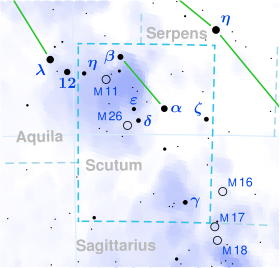Zeta Scuti
| Observation data Epoch J2000 Equinox J2000 | |
|---|---|
| Constellation | Scutum |
| Right ascension | 18h 23m 39.58309s[1] |
| Declination | −8° 56′ 03.7885″[1] |
| Apparent magnitude (V) | 4.66[2] |
| Characteristics | |
| Spectral type | G9 IIIb Fe-0.5[3] |
| U−B color index | +0.72[4] |
| B−V color index | +0.94[4] |
| Astrometry | |
| Radial velocity (Rv) | −5.02[5] km/s |
| Proper motion (μ) | RA: +49.59[1] mas/yr Dec.: +51.24[1] mas/yr |
| Parallax (π) | 15.78 ± 1.02 mas[1] |
| Distance | 210 ± 10 ly (63 ± 4 pc) |
| Absolute magnitude (MV) | 0.66[2] |
| Orbit[6] | |
| Primary | ζ Scuti A |
| Companion | ζ Scuti B |
| Period (P) | 2373.7 days |
| Semi-major axis (a) | 21.6 mas |
| Eccentricity (e) | 0.1 |
| Inclination (i) | 89° |
| Longitude of the node (Ω) | 226° |
| Periastron epoch (T) | 2418278.3 |
| Argument of periastron (ω) (secondary) | 242.1° |
| Details | |
| Mass | 1.29[7] M☉ |
| Radius | 9.3[7] R☉ |
| Luminosity | 62.04[2] L☉ |
| Surface gravity (log g) | 2.61[7] cgs |
| Temperature | 4,750[8] K |
| Metallicity [Fe/H] | −0.08[2] dex |
| Rotational velocity (v sin i) | 1.5[9] km/s |
| Other designations | |
| Database references | |
| SIMBAD | data |
Zeta Scuti, Latinized from ζ Scuti, is the Bayer designation for a star in the southern constellation of Scutum. It is a faint star but visible to the naked eye with an apparent magnitude of 4.66.[2] The distance to this star, as determined via parallax measurement, is around 210 light years. It is moving closer to the Sun with a radial velocity of −5 km/s.[5]
This is an astrometric binary system with a period of 6.5 years (2,374 days) and an orbital eccentricity of 0.10.[3] The visible component is an aging giant star of type G with a stellar classification of G9 IIIb Fe−0.5.[3] The suffix notation indicates the spectrum displays a mild underabundance of iron. It has 1.29 times the mass of the Sun and has expanded to 9.3 times the Sun's radius.[7] The star is radiating 62[2] times the Sun's luminosity from its enlarged photosphere at an effective temperature of 4,750 K.[8]
References
[edit]- ^ a b c d e van Leeuwen, F. (November 2007), "Validation of the new Hipparcos reduction", Astronomy and Astrophysics, 474 (2): 653–664, arXiv:0708.1752, Bibcode:2007A&A...474..653V, doi:10.1051/0004-6361:20078357, S2CID 18759600.
- ^ a b c d e f Anderson, E.; Francis, Ch. (2012). "XHIP: An extended hipparcos compilation". Astronomy Letters. 38 (5): 331. arXiv:1108.4971. Bibcode:2012AstL...38..331A. doi:10.1134/S1063773712050015. S2CID 119257644. Vizier catalog entry
- ^ a b c Eggleton, P. P.; Tokovinin, A. A. (September 2008), "A catalogue of multiplicity among bright stellar systems", Monthly Notices of the Royal Astronomical Society, 389 (2): 869–879, arXiv:0806.2878, Bibcode:2008MNRAS.389..869E, doi:10.1111/j.1365-2966.2008.13596.x, S2CID 14878976.
- ^ a b Mallama, A. (2014). "Sloan Magnitudes for the Brightest Stars". The Journal of the American Association of Variable Star Observers. 42 (2): 443. Bibcode:2014JAVSO..42..443M.Vizier catalog entry
- ^ a b Pourbaix, D.; Tokovinin, A. A.; Batten, A. H.; Fekel, F. C.; Hartkopf, W. I.; Levato, H.; Morrell, N. I.; Torres, G.; Udry, S. (2004). "SB9: The ninth catalogue of spectroscopic binary orbits". Astronomy and Astrophysics. 424 (2): 727–732. arXiv:astro-ph/0406573. Bibcode:2004A&A...424..727P. doi:10.1051/0004-6361:20041213. S2CID 119387088.
- ^ Jancart, S. (2005). "Astrometric orbits of SB9 stars". Astronomy and Astrophysics. 442 (1): 365–380. arXiv:astro-ph/0507695. Bibcode:2005A&A...442..365J. doi:10.1051/0004-6361:20053003. S2CID 15123997.
- ^ a b c d Allende Prieto, C.; Lambert, D. L. (1999). "Fundamental parameters of nearby stars from the comparison with evolutionary calculations: Masses, radii and effective temperatures". Astronomy and Astrophysics. 352: 555–562. arXiv:astro-ph/9911002. Bibcode:1999A&A...352..555A. Vizier catalog entry
- ^ a b Gontcharov, G. A. (2009). "Red giant clump in the Tycho-2 catalogue". Astronomy Letters. 34 (11): 785–796. arXiv:1607.00619. Bibcode:2008AstL...34..785G. doi:10.1134/S1063773708110078. S2CID 73524157. Vizier catalog entry
- ^ De Medeiros, J. R.; Alves, S.; Udry, S.; Andersen, J.; Nordström, B.; Mayor, M. (2014). "A catalog of rotational and radial velocities for evolved stars". Astronomy & Astrophysics. 561: A126. arXiv:1312.3474. Bibcode:2014A&A...561A.126D. doi:10.1051/0004-6361/201220762. S2CID 54046583. Vizier catalog entry

